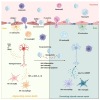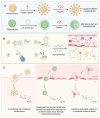Nanomaterial-Based Drug Delivery Systems for Ischemic Stroke
- PMID: 38140010
- PMCID: PMC10748360
- DOI: 10.3390/pharmaceutics15122669
Nanomaterial-Based Drug Delivery Systems for Ischemic Stroke
Abstract
Ischemic stroke is a leading cause of death and disability in the world. At present, reperfusion therapy and neuroprotective therapy, as guidelines for identifying effective and adjuvant treatment methods, are limited by treatment time windows, drug bioavailability, and side effects. Nanomaterial-based drug delivery systems have the characteristics of extending half-life, increasing bioavailability, targeting drug delivery, controllable drug release, and low toxicity, thus being used in the treatment of ischemic stroke to increase the therapeutic effects of drugs. Therefore, this review provides a comprehensive overview of nanomaterial-based drug delivery systems from nanocarriers, targeting ligands and stimulus factors of drug release, aiming to find the best combination of nanomaterial-based drug delivery systems for ischemic stroke. Finally, future research areas on nanomaterial-based drug delivery systems in ischemic stroke and the implications of the current knowledge for the development of novel treatment for ischemic stroke were identified.
Keywords: drug delivery; ischemic stroke; nanomaterials; nanoparticles; targeted therapy.
Conflict of interest statement
The authors declare no conflict of interest.
Figures


Similar articles
-
Advances in nanoparticle-based therapeutics for ischemic stroke: Enhancing drug delivery and efficacy.Biomed Pharmacother. 2024 Nov;180:117564. doi: 10.1016/j.biopha.2024.117564. Epub 2024 Oct 13. Biomed Pharmacother. 2024. PMID: 39405899 Review.
-
Polycystic Ovary Syndrome and the Potential for Nanomaterial-Based Drug Delivery in Therapy of This Disease.Pharmaceutics. 2024 Dec 4;16(12):1556. doi: 10.3390/pharmaceutics16121556. Pharmaceutics. 2024. PMID: 39771535 Free PMC article. Review.
-
Advanced drug delivery system against ischemic stroke.J Control Release. 2022 Apr;344:173-201. doi: 10.1016/j.jconrel.2022.02.036. Epub 2022 Mar 4. J Control Release. 2022. PMID: 35248645 Review.
-
Applications of Liposomal Drug Delivery Systems to Develop Neuroprotective Agents for the Treatment of Ischemic Stroke.Biol Pharm Bull. 2019;42(3):319-326. doi: 10.1248/bpb.b18-00683. Biol Pharm Bull. 2019. PMID: 30828062 Review.
-
The role of nanomaterials in revolutionizing ischemic stroke treatment: Current trends and future prospects.iScience. 2024 Nov 15;27(12):111373. doi: 10.1016/j.isci.2024.111373. eCollection 2024 Dec 20. iScience. 2024. PMID: 39669428 Free PMC article. Review.
Cited by
-
Revolutionizing Stroke Care: Nanotechnology-Based Brain Delivery as a Novel Paradigm for Treatment and Diagnosis.Mol Neurobiol. 2025 Jan;62(1):184-220. doi: 10.1007/s12035-024-04215-3. Epub 2024 Jun 3. Mol Neurobiol. 2025. PMID: 38829514 Review.
-
Construction of fibromodulin and borneol-clacked phosphorus dendrimer nanoparticles to reduce inflammation and oxidative stress in BBB to nursing care and ischemic stroke therapy.Naunyn Schmiedebergs Arch Pharmacol. 2025 May 24. doi: 10.1007/s00210-025-04250-4. Online ahead of print. Naunyn Schmiedebergs Arch Pharmacol. 2025. PMID: 40411619
-
LncRNA regulation in ischemic stroke and their application prospects.Neural Regen Res. 2026 Mar 1;21(3):1058-1073. doi: 10.4103/NRR.NRR-D-24-00924. Epub 2025 Mar 25. Neural Regen Res. 2026. PMID: 40145979 Free PMC article.
-
Extracellular vesicles: biological mechanisms and emerging therapeutic opportunities in neurodegenerative diseases.Transl Neurodegener. 2024 Dec 6;13(1):60. doi: 10.1186/s40035-024-00453-6. Transl Neurodegener. 2024. PMID: 39643909 Free PMC article. Review.
-
Microenvironment-responsive nanosystems for ischemic stroke therapy.Theranostics. 2024 Sep 3;14(14):5571-5595. doi: 10.7150/thno.99822. eCollection 2024. Theranostics. 2024. PMID: 39310102 Free PMC article. Review.
References
-
- Powers W.J., Rabinstein A.A., Ackerson T., Adeoy O.M., Bambakidis N.C., Becker K., Biller J., Hoh B., Jauch E.C., Kidwell C.S., et al. Guidelines for the Early Management of Patients with Acute Ischemic Stroke: 2019 Update to the 2018 Guidelines for the Early Management of Acute Ischemic Stroke: A Guideline for Healthcare Professionals from the American Heart Association/American Stroke Association. Stroke. 2019;50:e344–e418. - PubMed
Publication types
Grants and funding
- 31960178/National Natural Science Foundation of China
- 82160923/National Natural Science Foundation of China
- 82374425/National Natural Science Foundation of China
- 2019FA007/Applied Basic Research Programs of Science and Technology Commission Foundation of Yunnan Province
- 202301AU070013/Yunnan Fundamental Research Projects
LinkOut - more resources
Full Text Sources

